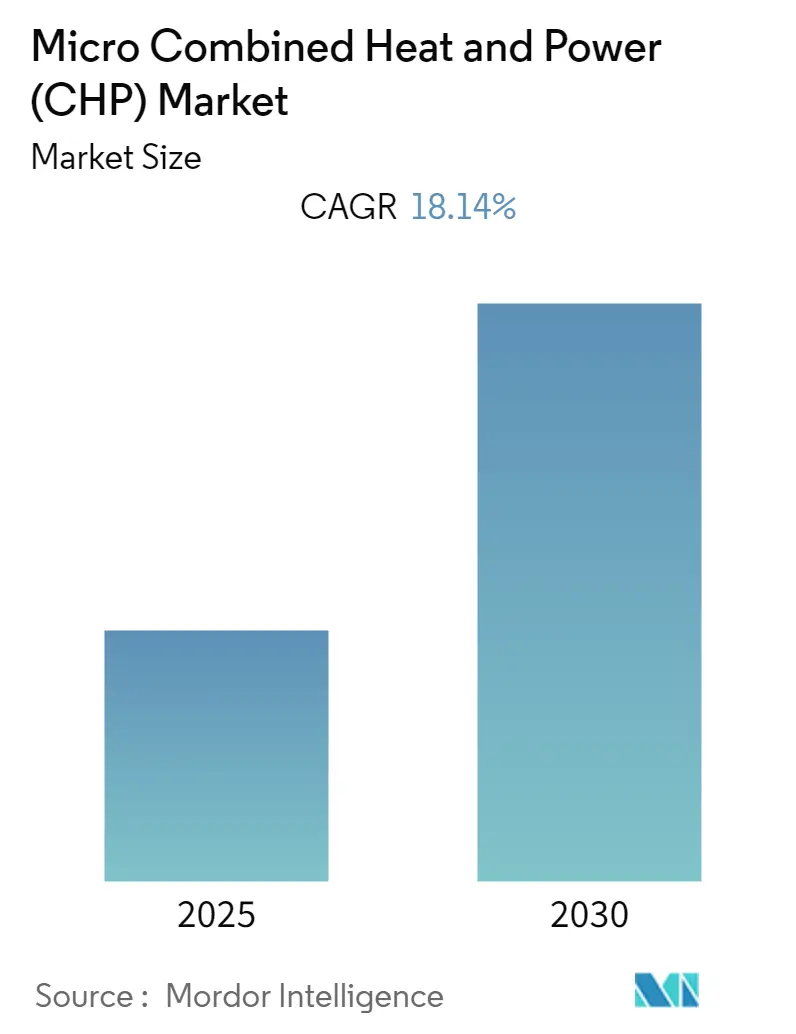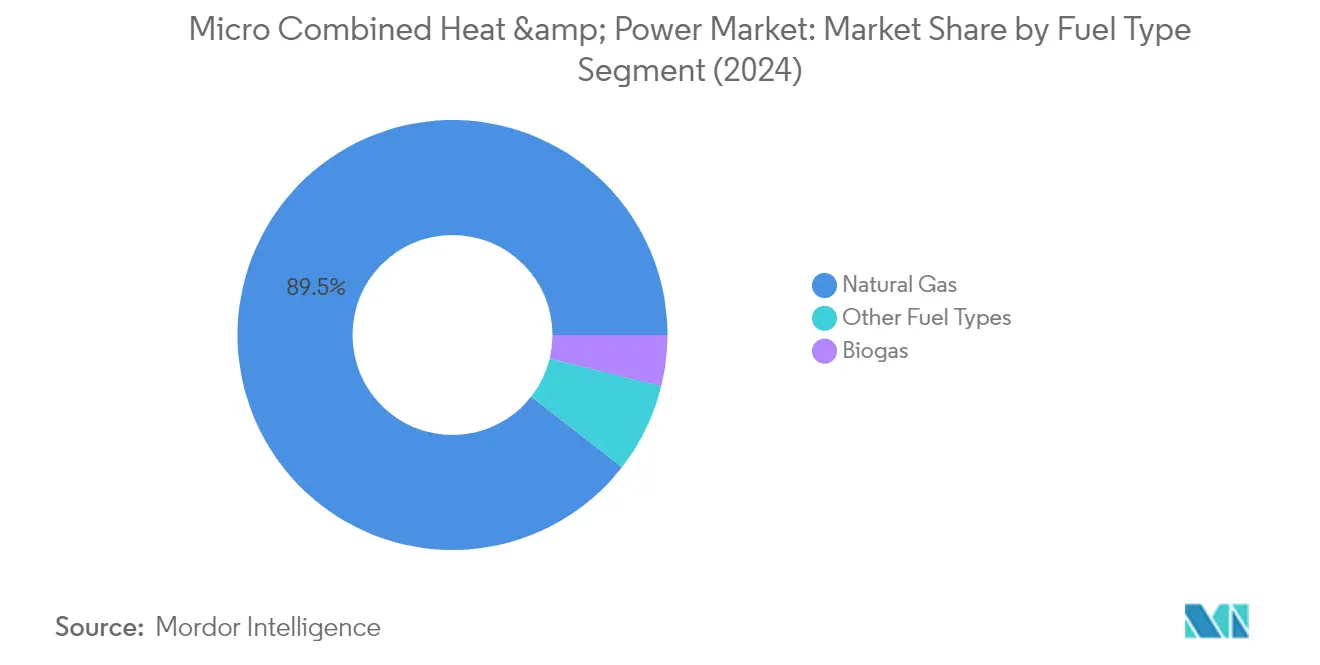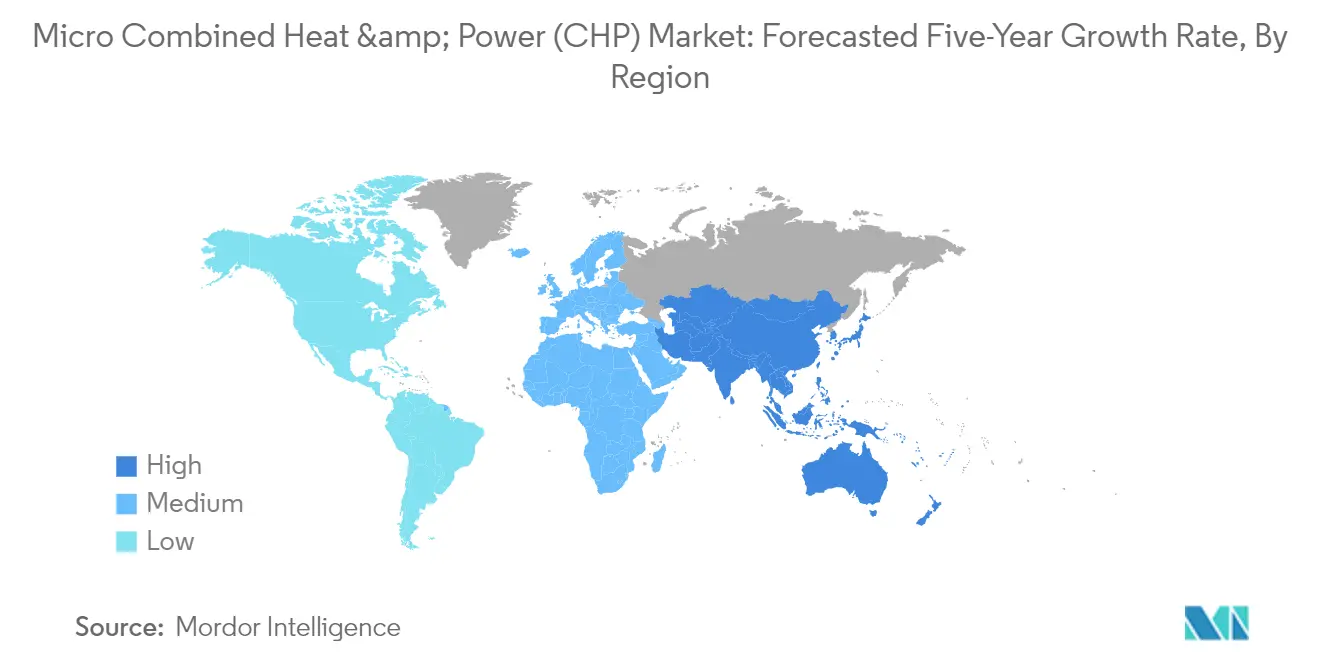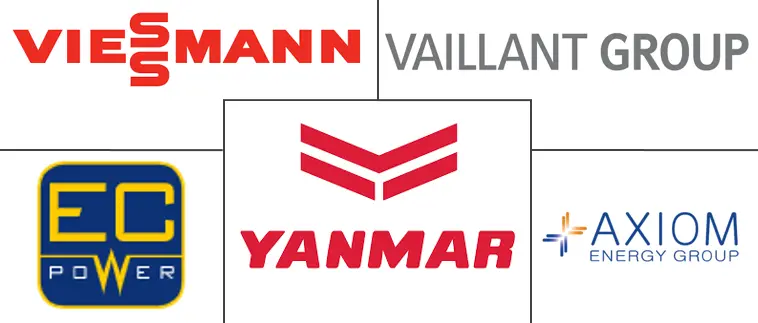Micro Combined Heat & Power (CHP) Market Size and Share

Micro Combined Heat & Power (CHP) Market Analysis by Mordor Intelligence
The Micro Combined Heat & Power Market is expected to register a CAGR of 18.14% during the forecast period.
The micro combined heat and power (CHP) industry is experiencing significant technological advancements, particularly in fuel cell technology integration. Modern micro CHP systems are achieving remarkable efficiency levels, with some units demonstrating total efficiency ratios of up to 109.2% and electrical efficiency rates of 33.2%. These improvements are driving the transition toward more sustainable and efficient energy solutions, particularly in residential and commercial applications. The industry is witnessing a strong push toward hydrogen-based solutions, exemplified by the September 2021 collaboration between Alkaline Fuel Cell Power Corp. (AFCP) and Gaskatel GmbH to develop next-generation power units based on alkaline fuel cell technology.
Government initiatives and supportive policies worldwide are reshaping the micro combined heat and power landscape. Japan's successful implementation of the Ene-Farm program has led to the deployment of approximately 306,000 fuel cell-based micro CHP systems, demonstrating the potential for widespread adoption when backed by proper policy support. Similarly, South Korea's ambitious Hydrogen Economy Roadmap aims to produce around 2.1 GW of micro fuel cells for households and buildings by 2040, highlighting the growing governmental commitment to sustainable energy solutions.
The industry is witnessing a significant shift toward renewable fuel sources and hybrid systems integration. Manufacturers are developing versatile systems capable of operating on various fuel types, including natural gas, biogas, and hydrogen, with some units achieving electrical efficiency rates of up to 60% when using solid oxide fuel cell technology. This flexibility in fuel options is crucial for meeting diverse regional energy requirements and environmental regulations while ensuring system reliability and performance optimization.
Technical innovations are driving improvements in system performance and maintenance requirements. Modern micro combined heat and power units are becoming increasingly sophisticated, featuring remote monitoring capabilities, reduced noise levels (some as low as 45 dB), and extended service intervals of up to 15,000 operating hours. These advancements are complemented by improved power output capabilities, with some systems capable of generating up to 50 kW of electrical output while maintaining thermal efficiency rates above 70%, making them increasingly attractive for various applications while reducing operational costs and environmental impact.
Global Micro Combined Heat & Power (CHP) Market Trends and Insights
Growing Demand for Energy Efficiency and Cost Savings
The increasing focus on energy efficiency and cost optimization has become a significant driver for the micro combined heat and power (CHP) market. Micro combined heat and power systems demonstrate remarkable efficiency levels, with smaller units achieving capacity factors of up to 95%, significantly higher than traditional separate heat and power generation systems. These systems offer exceptional versatility in fuel usage, capable of operating on traditional fuels like natural gas and LPG, while also being compatible with low-carbon alternatives such as biogas, renewable natural gas, hydrogen, and biodiesel, providing users with flexible fuel options to optimize operational costs.
The economic benefits of micro combined heat and power systems extend beyond fuel flexibility, as they provide substantial cost savings through reduced fuel consumption and efficient energy generation. While the initial capital investment for a residential micro-CHP system may be higher than conventional boiler systems, the installation process and costs remain comparable. Additionally, the maintenance and service costs are equivalent to standard boilers, though requiring specialized technicians, making them a cost-effective long-term investment for both residential and commercial applications. The systems' compact design, matching the size and shape of standard residential boilers, also eliminates the need for additional space allocation, further enhancing their economic viability.
Government Support and Incentives
Government initiatives and supportive policies have emerged as a crucial driver for the micro CHP market's growth globally. The success of programs like Japan's Ene-Farm initiative demonstrates the significant impact of government support, with the program achieving remarkable success in residential sector adoption. The United States has implemented comprehensive support mechanisms, offering various federal and state-level incentives, including grants and tax credits, alongside net metering policies specifically designed for residential micro-CHP users, creating a favorable environment for market expansion.
The commitment of various governments to promoting micro-CHP technology is further exemplified by South Korea's ambitious Hydrogen Economy Roadmap, which aims to establish a substantial micro fuel cell capacity for households and buildings. These government initiatives are complemented by special measure laws for new energy use and foreign direct investment policies in countries like Japan, which have accelerated market growth. The implementation of these supportive policies has not only made micro-CHP systems more financially accessible but has also contributed to increased public awareness and acceptance of the technology as a viable energy solution.
Increasing Focus on Grid Independence and Energy Security
The growing emphasis on grid independence and energy security has become a significant driver for the micro CHP market, particularly in regions prone to grid outages or natural disasters. Micro-CHP systems provide a reliable local energy source, offering an additional layer of resilience for remote households and communities that are susceptible to power disruptions. This capability for independent power generation has become increasingly valuable as communities seek to enhance their energy security and reduce dependence on centralized power infrastructure.
The ability of micro-CHP systems to operate autonomously from the main grid while simultaneously providing both heat and power makes them particularly attractive for ensuring continuous energy supply. This aspect of energy security is especially crucial for critical facilities and residential areas in regions with unreliable grid connections or extreme weather conditions. The systems' capacity to maintain essential services during grid outages, combined with their efficient operation during normal conditions, positions them as a strategic solution for both everyday energy needs and emergency situations, driving their adoption across various applications.
Environmental Benefits and Emission Reduction
Environmental considerations and the push for emission reduction have become powerful drivers in the combined heat and power market. These systems demonstrate impressive environmental performance through their high overall efficiency rates, with modern units achieving total system efficiencies of up to 85-99%, significantly reducing the carbon footprint compared to separate heat and power generation methods. The ability to integrate with renewable and low-carbon fuels further enhances their environmental credentials, making them increasingly attractive in regions with strict emission regulations.
The environmental benefits extend beyond operational efficiency, as micro-CHP systems contribute to reduced primary energy consumption through their cogeneration capability. Their ability to utilize waste heat that would otherwise be lost in conventional power generation systems represents a significant advancement in resource efficiency. This aspect is particularly important in the context of global sustainability goals and carbon reduction targets, making micro-CHP systems an attractive option for environmentally conscious consumers and businesses looking to reduce their environmental impact while maintaining reliable energy supply.
Segment Analysis: Fuel Type
Natural Gas Segment in Micro Combined Heat & Power Market
Natural gas dominates the micro combined heat and power (CHP) market, commanding approximately 89% of the total market share in 2024. This significant market position is attributed to the widespread availability of natural gas infrastructure, particularly in high-income countries with cold winters like Europe and Japan. The segment's dominance is further strengthened by the lower emissions compared to other fossil fuels, high efficiency rates of natural gas-based micro CHP systems, and established supply chain networks. Natural gas-based micro CHP units are particularly popular in residential applications due to their relatively quieter operation compared to other fuel types, making them ideal for domestic installations. The segment's growth is also supported by favorable government policies and incentives in key markets, particularly in Europe and Asia-Pacific regions, where natural gas-based micro CHP systems are increasingly being adopted for both residential and commercial applications.

Biogas Segment in Micro Combined Heat & Power Market
The biogas segment in the micro CHP market represents a growing opportunity for sustainable energy generation. The segment is experiencing significant growth driven by increasing environmental regulations and the push towards renewable energy sources. Biogas-based micro CHP systems offer unique advantages in terms of waste-to-energy conversion, particularly beneficial for establishments like hospitals, schools, and hotels that generate organic waste. The technology's ability to convert biogas into heat and electricity with approximately 50% heat efficiency and 35% electricity efficiency makes it an attractive option for sustainable energy generation. The segment's growth is further supported by government incentives for biogas production and associated infrastructure development, particularly in European countries where biogas is increasingly being recognized as a viable alternative to natural gas.
Remaining Segments in Fuel Type
Other fuel types in the micro CHP market, including heating oil and wood pellets, play a niche but significant role in specific regional markets. Wood-pellet-based micro CHPs have found particular success in European markets due to their stable pricing history compared to fluctuating natural gas and oil prices. However, these alternative fuel types face challenges due to their relatively lower efficiency compared to natural gas and biogas, combined with higher emission levels. The segment's impact is particularly notable in regions with established biomass supply chains and specific government support schemes for alternative fuel adoption. Despite these challenges, these fuel types continue to serve specific market needs, particularly in regions where natural gas infrastructure is limited or where local biomass resources are abundant.
Segment Analysis: Application
Residential Segment in Micro Combined Heat & Power Market
The residential segment dominates the micro combined heat and power market, accounting for approximately 97% of the total market share in 2024. This dominance is primarily driven by the increasing adoption of fuel cell-based micro CHP systems in residential applications, particularly in countries like Japan and Germany. The segment's growth is further supported by favorable government policies and incentives across major markets, with Europe viewing micro CHP as a critical component for reducing emissions from the residential heating sector. The residential micro CHP systems are especially suited to higher latitudes with colder winters, providing an effective solution for sectors with relatively lower energy demands. These systems can reduce fuel usage, leading to lower emissions and reduced costs, while providing an additional layer of resiliency for remote households susceptible to power loss due to grid outages or natural disasters.
Commercial Segment in Micro Combined Heat & Power Market
The commercial segment is experiencing rapid growth in the micro CHP market, driven by increasing adoption across hotels, supermarkets, office buildings, sports centers, hospitals, and data centers. The segment's growth is particularly notable in regions with high electricity tariffs and supportive government policies for commercial-scale micro CHP installations. Commercial micro CHP systems are typically larger than residential systems but smaller than 50 kW, primarily utilizing internal combustion engine CHPs with higher electrical efficiency. The segment is witnessing a significant shift towards fuel cell technology, as falling costs and rising efficiency make it increasingly attractive for commercial applications. This transition is particularly evident in sectors like supermarkets, where more than 50% of the total energy consumption comes from refrigeration, lighting, and HVAC systems, making micro CHP an ideal solution for meeting their energy demands.
Micro Combined Heat & Power (CHP) Market Geography Segment Analysis
Micro Combined Heat & Power (CHP) Market in North America
The North American micro combined heat and power market, accounting for approximately 0.3% of the global market share in 2024, remains in its nascent phase but demonstrates significant potential for growth. The region's market development is primarily driven by an increasing shift toward independence from grid-based power and supportive government policies. The United States leads the regional market with a growing focus on residential and commercial applications, particularly in states like Connecticut, California, Massachusetts, New York, and New Jersey. The market benefits from various federal and state-level incentives, including grants and tax credits, alongside net metering policies for residential micro CHP users. Canada's vast geography and harsh climate create ideal conditions for grid-independent electricity and heat generation, though market penetration remains limited due to the widespread availability of cheap hydroelectric power. The region's potential is particularly notable in the residential sector, with the United States alone comprising 122 million households that account for 21% of the nation's total energy consumption. Despite current limited deployment, the micro CHP market shows promise for expansion, especially in areas with high electricity tariffs and an increasing focus on energy resilience.

Micro Combined Heat & Power (CHP) Market in Europe
Europe stands as one of the largest markets for micro combined heat and power, experiencing a robust growth rate of nearly 7% from 2019 to 2024. The market's strong performance is underpinned by favorable government policies, stringent emissions requirements for utility-sized power plants, and an increasing shift toward grid-independent power generation. Germany leads the regional market with significant micro CHP installations, supported by comprehensive government incentives and high electricity tariffs. The United Kingdom has emerged as another key market, particularly in the residential sector, with an estimated 14-18 million households considered suitable for micro CHP installations. The region's commitment to reducing carbon emissions has positioned micro combined heat and power as a critical component in achieving environmental goals, particularly in the residential heating sector. Northern European countries, with their colder climates and established natural gas infrastructure, show particularly strong adoption rates. The market benefits from various support schemes, including feed-in tariffs, tax credits, and CHP certificates across different European nations, creating a favorable environment for continued market expansion.
Micro Combined Heat & Power (CHP) Market in Asia-Pacific
The Asia-Pacific region dominates the global micro combined heat power market and is projected to maintain a substantial growth trajectory of approximately 20% annually from 2024 to 2029. Japan leads the regional market with its highly successful fuel cell commercialization programs, particularly the Ene-farm program, which has achieved widespread adoption in both residential and commercial sectors. The country's commitment to grid-independent power generation and favorable government policies continues to drive market growth. South Korea follows as another significant market player, with ambitious plans outlined in its Hydrogen Economy Roadmap. The region's market dynamics are further enhanced by rapid technological advancements in micro CHP systems, particularly in fuel cell technology. China's emerging market presence, coupled with an increasing focus on renewable energy integration and energy efficiency, contributes to the region's dominant position. The combination of supportive government initiatives, technological innovation, and growing awareness of energy efficiency benefits positions Asia-Pacific as the most dynamic combined heat and power market.
Micro Combined Heat & Power (CHP) Market in South America
The South American micro CHP market exhibits relatively modest development compared to other regions, characterized by selective adoption and specific market challenges. Brazil, despite being the largest regional economy, faces unique market dynamics due to its abundant hydroelectric resources, which somewhat limit the immediate appeal of micro CHP systems. However, commercial operations, particularly in sectors like sugar cane mills, laundries, and office buildings, show promising potential for micro CHP adoption. Chile has integrated CHP development into its 2050 Energy Agenda, demonstrating a long-term commitment to the technology. Argentina's government is actively promoting alternative energy sources and small-scale generation projects, including those utilizing biogas and biomass, which could benefit the micro CHP market. The region's tropical climate necessitates different approaches to micro CHP implementation, with a greater emphasis on cooling capabilities in residential applications. Despite current limitations, the market shows potential for growth, particularly in commercial and industrial applications where heat requirements align well with micro CHP capabilities.
Micro Combined Heat & Power (CHP) Market in Middle East & Africa
The Middle East & Africa region presents a unique market landscape for micro combined heat and power systems, characterized by distinct regional variations and emerging opportunities. In the Middle East, countries are increasingly focusing on hydrogen as a clean energy source, with Saudi Arabia aiming to become a global leader in hydrogen exports. This strategic shift could potentially benefit the micro CHP market, particularly in applications requiring climate-neutral heat for local heating networks, residential buildings, and industrial plants. The Gulf region's commercial and residential buildings, with their high electricity consumption patterns, present opportunities for micro CHP systems with cooling capabilities or trigeneration units. In Africa, particularly Sub-Saharan regions, the market potential is closely tied to rural electrification needs and the challenge of unreliable grid infrastructure. South Africa shows particular interest in hybrid solutions, combining mCHP units with solar power sources to achieve clean and consistent distributed power generation. However, factors such as warm weather conditions, fragile economic conditions, and infrastructure limitations continue to influence the pace of market development in the region.
Competitive Landscape
Top Companies in Micro Combined Heat & Power Market
The micro combined heat and power market features established players like Yanmar Holdings, Viessmann Group, 2G Energy, ATCO Ltd, and other innovative companies driving industry growth. Companies are increasingly focusing on technological advancement, particularly in developing more efficient and environmentally friendly CHP systems, including hydrogen and biogas-powered solutions. Strategic partnerships and acquisitions have become crucial for expanding market presence, as demonstrated by collaborations between major players to enhance distribution networks and technological capabilities. Product innovation remains central to competitive strategy, with companies investing in R&D to develop smart, integrated systems that offer higher efficiency and lower emissions. The industry has witnessed a significant push toward developing solutions for both residential and commercial applications, with manufacturers expanding their product portfolios to cater to diverse customer needs.
Dynamic Market with Strong Regional Players
The micro CHP market exhibits a moderately fragmented structure with a mix of global conglomerates and specialized regional players. Global companies like Yanmar and Viessmann leverage their extensive distribution networks and technological expertise, while regional specialists focus on developing market-specific solutions and maintaining strong local customer relationships. The market has witnessed significant consolidation through strategic acquisitions and partnerships, as demonstrated by Viessmann's partnership with Koelplan in the Netherlands and Enginuity Power Systems' acquisition of Katech.
The competitive landscape is characterized by strong regional variations in market leadership, with different players dominating specific geographical markets based on their technological expertise and local market understanding. Companies are increasingly pursuing vertical integration strategies, as seen in the supply chain developments where manufacturers are forming strategic alliances with component suppliers and distribution partners. The industry has also witnessed a trend toward collaborative innovation, with companies partnering with research institutions and technology providers to develop next-generation micro combined heat and power solutions.
Innovation and Adaptability Drive Market Success
Success in the combined heat and power market increasingly depends on companies' ability to develop cost-effective, efficient solutions while maintaining technological leadership. Incumbent players are focusing on expanding their service offerings, developing comprehensive maintenance programs, and building stronger relationships with installers and distributors. The ability to offer flexible financing options and demonstrate clear cost benefits to end-users has become crucial for market success, particularly in the residential sector where initial installation costs remain a significant barrier.
Market contenders are finding opportunities by focusing on specific market niches, such as renewable-based micro CHP manufacturers or specialized commercial applications. The industry's future success factors include the ability to adapt to evolving environmental regulations, integrate with smart home systems, and provide solutions that complement renewable energy sources. Companies must also address the growing importance of digitalization, offering remote monitoring capabilities and predictive maintenance features while ensuring their products remain competitive against alternative heating and power solutions.
Micro Combined Heat & Power (CHP) Industry Leaders
-
Viessmann Group
-
Axiom Energy Group, LLC.
-
EC Power A/S
-
Yanmar Holdings Co. Ltd
-
Vaillant Group
- *Disclaimer: Major Players sorted in no particular order
_Market.webp)
Recent Industry Developments
- A micro-CHP project worth EUR 199,956.88 was launched on November 2021, during a public engagement event held at the EsploraPlanetarium at Esplora Interactive Science Centre in Kalkara, under the MCST Fusion R&I Programme. This programme is a collaboration between the University of Malta and Abertax Kemtronics Ltd. The launched project has an efficiency of more than 85%, thus, enabling the development of a compact, efficient, and low-cost unit of combined heat and power system ideal for small homes.
- In April 2020, Magnex and Elcogen signed LOI commercial agreement for SOFC commercialization. Magnex Co. Ltd is developing a 250 W SOFC portable system, 1 kW SOFC cell stack, and 1-5 kW SOFC combined heat and power generation (CHP) system, which is fueled by bio-gas or ethanol. The company is targeting Japanese and Korean markets with the help of Elcogen's low operating temperature technology, thus, allowing the use of low-cost materials and cost-efficient system design.
- In August 2020, the Axiom Energy Group planned to launch distributed micro combined heat and power (mCHP) systems. This distribution of mCHP systems was made through ATCO Group, thus bringing affordable, clean energy to customers throughout the North American region. The mCHP systems produce electricity as a by-product of heat generated for hot water or open space heating. This process is highly efficient (more than 93%) and with near-zero emissions.
Global Micro Combined Heat & Power (CHP) Market Report Scope
The micro combined heat & power (CHP) market report includes:
| Natural Gas |
| Biogas |
| Other Fuel Types |
| Residential |
| Commercial |
| North America |
| Europe |
| Asia-Pacific |
| South America |
| Middle-East and Africa |
| Fuel Type | Natural Gas |
| Biogas | |
| Other Fuel Types | |
| Application | Residential |
| Commercial | |
| Geography | North America |
| Europe | |
| Asia-Pacific | |
| South America | |
| Middle-East and Africa |
Key Questions Answered in the Report
What is the current Micro Combined Heat & Power (CHP) Market size?
The Micro Combined Heat & Power (CHP) Market is projected to register a CAGR of 18.14% during the forecast period (2025-2030)
Who are the key players in Micro Combined Heat & Power (CHP) Market?
Viessmann Group, Axiom Energy Group, LLC., EC Power A/S, Yanmar Holdings Co. Ltd and Vaillant Group are the major companies operating in the Micro Combined Heat & Power (CHP) Market.
Which is the fastest growing region in Micro Combined Heat & Power (CHP) Market?
Asia-Pacific is estimated to grow at the highest CAGR over the forecast period (2025-2030).
Which region has the biggest share in Micro Combined Heat & Power (CHP) Market?
In 2025, the Asia-Pacific accounts for the largest market share in Micro Combined Heat & Power (CHP) Market.
What years does this Micro Combined Heat & Power (CHP) Market cover?
The report covers the Micro Combined Heat & Power (CHP) Market historical market size for years: 2020, 2021, 2022, 2023 and 2024. The report also forecasts the Micro Combined Heat & Power (CHP) Market size for years: 2025, 2026, 2027, 2028, 2029 and 2030.
Page last updated on:



